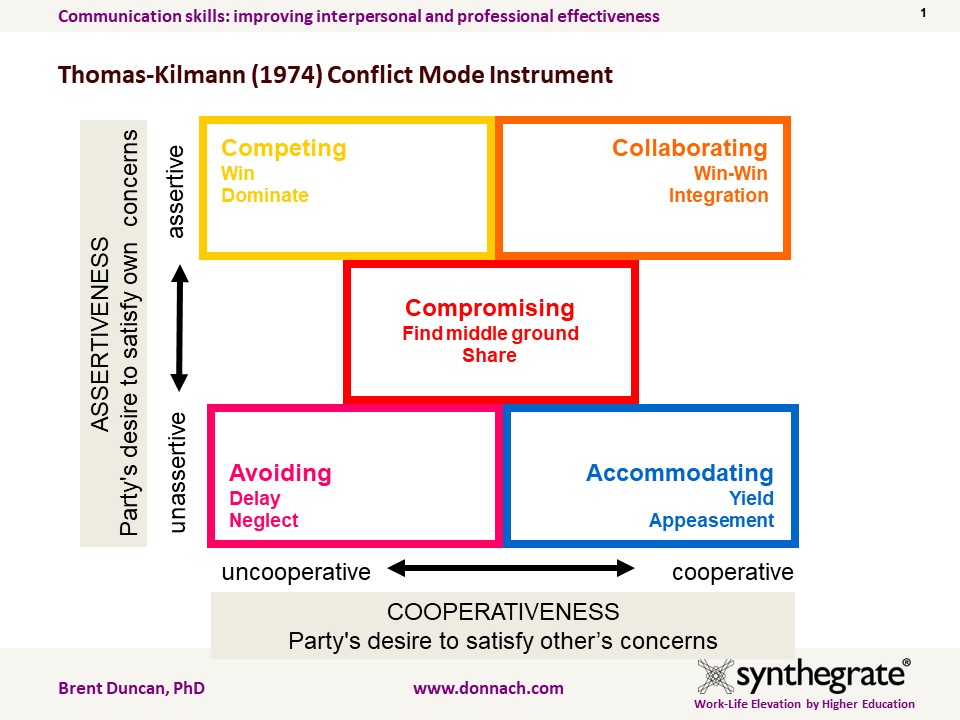Different styles for different conflicts
Whether a conflict is functional or dysfunctional, effective team communication can help enhance cohesiveness by managing conflict for positive outcomes. Kenneth Thomas and Ralph Kilman (1974, 2001) proposed that individuals who face conflict exhibit behavior along two dimensions: assertiveness and cooperation.
- Assertiveness means that the individual attempts to satisfy their interests.
- Cooperation means that the individual attempts to satisfy the interests of others.
Using the dimensions of assertiveness and cooperation, Thomas and Kilman developed a model that identifies five basic styles for dealing with conflict: Competing, Collaborating, Compromising, Avoiding, and Accommodating [See Image 3]. Understanding these communication styles can help team members to determine the correct communication style for specific situations.
 Image 3: Different styles for different conflicts: Thomas-Kilmann Conflict Mode Instrument (1974, 2001).
Image 3: Different styles for different conflicts: Thomas-Kilmann Conflict Mode Instrument (1974, 2001).
Competing
The goal of the person practicing the competing style is to win. The underlying psychology of competing is high on assertiveness and low on cooperation. Competing can be appropriate when:
- Quick and decisive action is essential, like in emergencies.
- You know you are right on an issue vital to team success.
Competing can be exciting for the individual who wants to exercise a personal sense of power. However, competing can alienate others, increases your chances of losing everything, and discourages others from working with you.
Collaborating
Collaborating is appropriate when trying to create a situation in which all members can feel like they have won. The collaborator is simultaneously high on assertiveness and cooperation. Collaborating is appropriate when the concerns of all parties are too significant to be compromised, so you need to find an integrative solution that considers everyone’s interests. Collaborating can also help participants learn, build creative solutions by merging perspectives, and strengthen commitment through consensus.
The benefits of collaboration are that all parties can win, maintain and strengthen relationships, and improve the quality of your solutions.
A risk of collaborating is that it can alienate everyone while resulting in a solution that no one is satisfied with.
Compromising
The goal of compromising is to find the middle ground; this involves moderate assertiveness and moderate cooperation. Compromising is appropriate when the goals are necessary but not worth disrupting with more assertive methods. Compromise can also help to:
- Achieve temporary settlements to complex issues.
- Arrive at expedient solutions under time pressure.
- Provide a backup when collaborating and competing are unsuccessful.
The possible advantages of compromising are that everyone gets something out of the solution. Compromise can create a sense of harmony and encourage creativity.
A critical risk with compromising is that none of the parties may be satisfied, so the conflict can resurface later. Also, attempts to create a sense of harmony through compromise can lead to complacency and groupthink, which can diminish team effectiveness.
Avoiding
The goal of avoiding is to delay or ignore conflict. The psychology of avoiding is simultaneously low on assertiveness and cooperation.
Although avoiding conflict usually makes matters worse, avoidance does have some practical applications. For example,
- When an issue is trivial or when you face more critical problems.
- If you feel you have no chance of satisfying your concerns, it might be better to avoid conflict.
Other applications for avoidance include the following:
- Considering if the potential disruption from different styles can outweigh the benefits of resolution.
- As a temporary measure to let people cool down and regain perspective.
- When more information is for making better decisions.
- When others can resolve the conflict better than you can.
The key benefit of avoiding conflict is that you do not have to put any energy into resolving the conflict.
Avoidance comes with some serious risks, such as the following:
- Problems usually get worse; they do not resolve themselves.
- You are losing an opportunity to understand the needs of others.
- You may be missing an ability to understand and deal with your environment.
Accommodating
The goal of accommodating is to yield your interests to others. This approach is low on assertiveness and high on cooperation. Appropriate applications of the accommodating style are as follows:
- You decide that the other positions are more critical than yours.
- You want to minimize loss when you are outmatched or losing.
- You feel that maintaining harmony and stability is especially important.
The potential benefits of accommodating are that you do not cause any problems, others may view you as supportive, and you can save energy for other pursuits.
On the negative side, accommodating as a matter of habit can
- Lower self-esteem.
- Cause you to lose influence with others.
- Prevent you from making significant contributions to the group.
- Make others dependent on your cooperation and resistant when you decide to assert yourself.


![Communication is a process of negotiating to create shared understanding [Image: CoPilot] Communication is a process of negotiating to create shared understanding [Image: CoPilot]](/images/Images/a_man_and_a_woman_creating_shared_meaning_through_communication500.png)



![Your brain can keep growing, adapting, and learning at any age, if you are willing to put in the effort [Image: Copilot]](/images/Images/best-years-for-adult-brain300.png)
